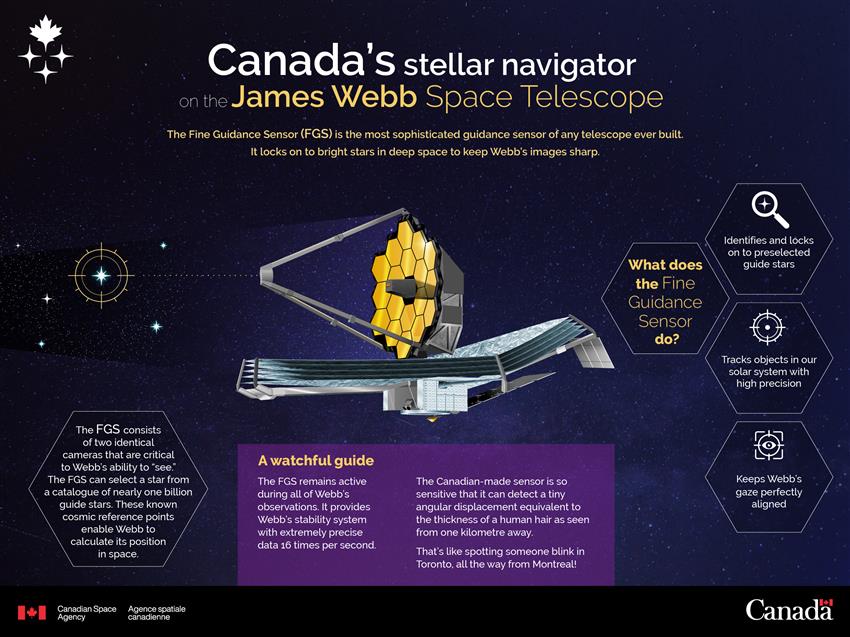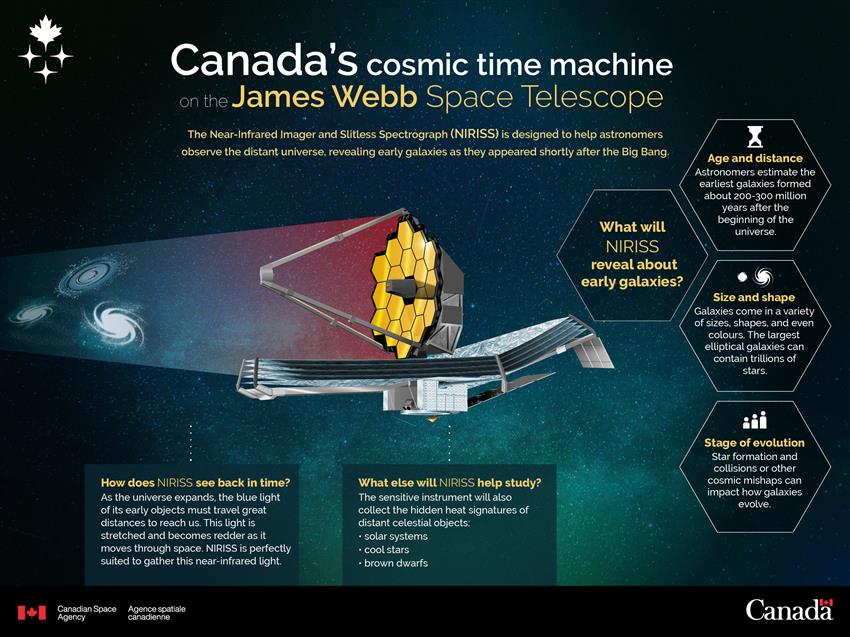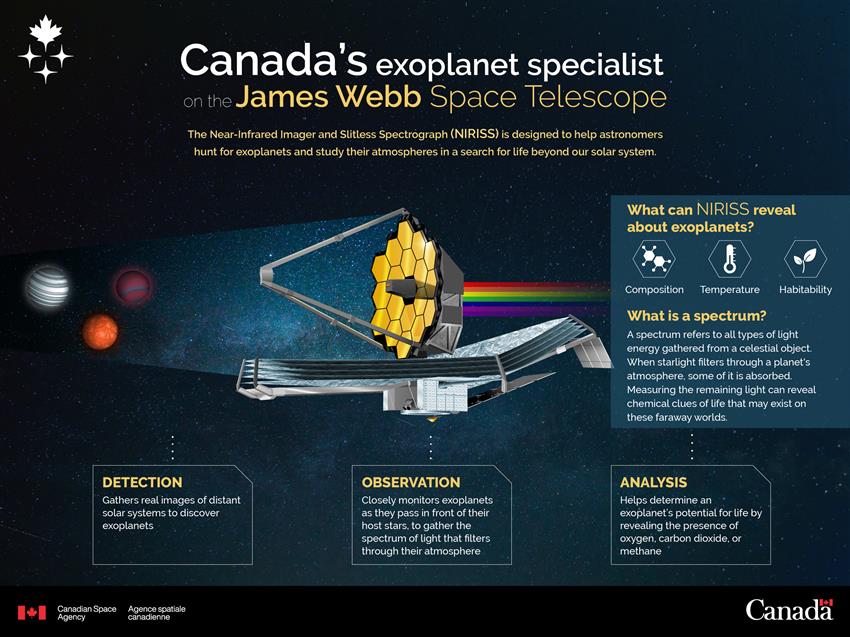Canada's role in Webb
The James Webb Space Telescope is the most important space observatory of the next decade, serving astronomers from all over the world. It is an international collaboration between NASA, the European Space Agency and the Canadian Space Agency (CSA).
The CSA has contributed two important elements, built by Honeywell, to the Webb Telescope:
- the Fine Guidance Sensor (FGS), which allows the telescope to point at and focus on objects of interest
- the Near-Infrared Imager and Slitless Spectrograph (NIRISS), a scientific instrument that helps study many astronomical objects, from exoplanets to distant galaxies
In exchange, Canada receives a guaranteed share of Webb's observation time, making Canadian scientists some of the first to study data collected by the most advanced space telescope ever built.
Canada's contribution

Canada's Fine Guidance Sensor (FGS) and the Near-Infrared Imager and Slitless Spectrograph (NIRISS) at NASA's Goddard Space Flight Center. (Credit: NASA)
Fine Guidance Sensor: Keeping Webb on target
The Canadian-made FGS allows Webb to:
- determine its position
- locate its celestial targets
- track moving targets
- remain steadily locked or pointed, with very high precision, on a specific celestial target
The FGS plays an important role in all scientific observations made by Webb and ensures the collection of clear and detailed pictures of celestial bodies in the universe.

Text version - Canada's stellar navigator on the James Webb Space Telescope - infographic
The James Webb Space Telescope will be the most important space observatory of the next decade, serving astronomers from all over the world. One of the two Canadian elements on the James Webb Space Telescope, the FGS is the most sophisticated guidance sensor of any telescope ever built. It locks on to bright stars in deep space to keep Webb's images sharp. (Credit: CSA)
Near-Infrared Imager and Slitless Spectrograph
The Canadian NIRISS instrument enables scientists to determine the composition of exoplanets' atmospheres, observe distant galaxies, and examine objects that are very close together.
Using a camera sensitive to infrared wavelengths, NIRISS captures the infrared light emitted by objects and gathers information about the spectra of distant planets.
A spectrum shows exactly how bright an object is at many different wavelengths, or colours. This gives detailed information on the characteristics of the observed object.
With the Webb Telescope, scientists will be able to determine if distant planets could be habitable based on whether or not their spectra show lines associated with certain molecules like water, carbon dioxide, methane and oxygen in their atmospheres.

Text version - NIRISS, Canada's cosmic time machine on the James Webb Space Telescope - infographic
The James Webb Space Telescope, often referred to as Hubble's successor, promises to push the limits of astronomy even more and study some of the very first galaxies ever created, only 200 million years after the event that began the entire universe. The CSA is contributing the NIRISS, a scientific instrument that will help study many astronomical objects, from exoplanets to distant galaxies. (Credit: CSA)

Text version - NIRISS, Canada's exoplanet specialist on the James Webb Space Telescope - infographic
One of the two Canadian elements on the James Webb Space Telescope, the NIRISS, was designed specifically to study the starlight streaming through exoplanet atmospheres and determine their composition. (Credit: CSA)
The Canadian teams
Science team
The CSA is supporting the science team's operations. The science team is responsible for selecting scientific targets and goals that involve the use of the Canadian instrument NIRISS during guaranteed time observations made during Webb's lifetime.

Leads of the Canadian FGS/NIRISS team, Dr. René Doyon (Université de Montréal), Dr. Begoña Vila (NASA), Dr. Chris Willott (NRC-Herzberg) and Dr. Neil Rowlands (Honeywell), discuss testing of the Webb Telescope at NASA's Goddard Space Flight Center. (Credit: Julia Zhou/Honeywell)
The Canadian Webb science team is led by:
- Principal Investigator Dr. René Doyon, Université de Montréal
- Project Scientist Dr. Chris Willott, National Research Council Canada's Herzberg Astronomy and Astrophysics Research Centre
Researchers from a number of universities and institutes are involved in the Canadian science team:
- National Research Council Canada's Herzberg Astronomy and Astrophysics Research Centre
- Saint Mary's University
- Université de Montréal
- University of Toronto
- York University
- Cornell University
- Space Telescope Science Institute
- University of Michigan
- University of Rochester
Instrument team
The FGS/NIRISS instrument team was responsible for designing and developing the Canadian contribution to Webb.
The integrated FGS/NIRISS unit was built and tested by Honeywell with the help of scientists and engineers from the CSA, the Université de Montréal, NASA, and the Space Telescope Science Institute.
The CSA is funding Canada's entire contribution to the space telescope, including the two Canadian hardware elements and the continued participation of instrument scientists.
